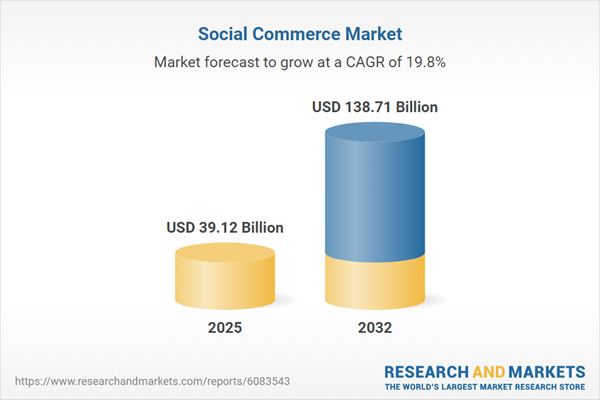Speak directly to the analyst to clarify any post sales queries you may have.
The social commerce market is undergoing rapid transformation as social platforms, brands, and consumers increasingly integrate purchasing activities into digital interactions. Senior decision-makers must recognize the convergence of social media engagement, frictionless payments, and evolving consumer expectations as a new frontier for sustainable commerce growth.
Market Snapshot: Social Commerce Market Size and Growth
The global social commerce market grew from USD 32.63 billion in 2024 to USD 39.12 billion in 2025. It is projected to grow at a 19.82% CAGR, reaching USD 138.71 billion by 2032. Expansion is driven by platform innovation, advanced shopping experiences, and shifting consumer behaviors, positioning social commerce as a pivotal channel within omnichannel strategies. Leading platforms are investing in shoppable content and native payment functionality, enhancing the value proposition for businesses seeking direct engagement and conversion opportunities within social environments.
Scope & Segmentation of the Social Commerce Market
This research report delivers comprehensive insights into market trends and future opportunities across platform types, product categories, business models, commerce formats, payment methods, engagement types, customer demographics, and regions. The coverage ensures executive stakeholders understand where to focus investments and adapt strategies for optimal impact.
- Platform Type: Facebook (in-stream video, live shopping), Instagram (reels shopping, stories shopping), Pinterest (product pins, shop tab), Snapchat (shoppable AR, Snap Store), TikTok (in-feed commerce, live shopping), WhatsApp (catalog checkout, in-chat checkout)
- Product Category: Apparel & accessories (children's, men's, women's), beauty & personal care (haircare, makeup, skincare), electronics & media (home appliances, laptops, smartphones), food & beverage (beverages, fresh produce, packaged foods), home & living (furniture, home decor, kitchenware)
- Business Model: Business to business, business to consumer, consumer to consumer
- Commerce Format: Live commerce, shoppable posts, shoppable videos
- Payment Method: Bank transfer, cash on delivery, credit card, digital wallet
- Engagement Type: Content driven, influencer driven, peer driven
- Customer Demographic: Baby Boomers, Generation X, Millennials, Generation Z
- Regional Coverage: Americas (North and Latin America), Europe, Middle East and Africa, Asia-Pacific
- Key Companies: Tencent Holdings Limited, Alibaba Group Holding Limited, Pinduoduo Inc., ByteDance Ltd., Meta Platforms, Inc., Amazon.com, Inc., JD.com, Inc., Shopify Inc., Pinterest, Inc., Snap Inc.
Key Takeaways for Strategic Decision-Makers
- Social commerce success relies on orchestrating content, community, and commerce, empowering brands to deepen direct-to-consumer relationships and improve revenue potential.
- Mobile-first video, live shopping, and shoppable posts enable real-time discovery and transaction, demanding continuous adaptation of content formats and user experiences.
- First-party data strategies and privacy compliance are becoming critical, driving brands to foster trust through value-driven engagement and transparent communication.
- Innovation in payment integration and checkout experiences reduces friction, and strengthens platform loyalty among diverse consumer segments.
- Companies collaborating with logistics providers and regional partners can mitigate operational complexities, streamline fulfillment, and adapt to local market needs.
- Staying attuned to regional variations in payment preferences, influencer culture, and regulatory standards is essential for scalable growth and risk management.
Tariff Impact on Global Social Commerce Operations
Recent tariff measures in the United States have added new complexities to international supply chains and pricing structures for social commerce brands. Companies are revisiting supplier networks, reworking logistics strategies, and adopting more localized production models to mitigate increased costs and longer lead times. Risk mitigation now depends on diversified suppliers, distributed warehousing, and agile pricing, ensuring operational resilience under shifting geopolitical conditions.
Methodology & Data Sources
Analysis leverages a hybrid approach, including executive interviews, survey data from varied consumer segments, reviews of corporate disclosures, and validation through expert roundtables. This rigorous method ensures recommendations are grounded in both primary and secondary sources reflective of the market reality.
Why This Report Matters
- Provides strategic guidance for optimizing investments in emerging social commerce segments, platforms, and technologies.
- Helps executives anticipate competitive shifts, consumer behaviors, and regulatory impacts that influence market positioning.
- Supports informed decision-making required for risk mitigation and sustainable growth.
Conclusion
As social platforms and commerce models evolve, adopting data-driven, regionally adaptable strategies is imperative. Senior leaders who leverage these insights will be best positioned to accelerate growth and maintain relevance in a competitive social commerce arena.
Table of Contents
3. Executive Summary
4. Market Overview
7. Cumulative Impact of Artificial Intelligence 2025
Companies Mentioned
The companies profiled in this Social Commerce market report include:- Tencent Holdings Limited
- Alibaba Group Holding Limited
- Pinduoduo Inc.
- ByteDance Ltd.
- Meta Platforms, Inc.
- Amazon.com, Inc.
- JD.com, Inc.
- Shopify Inc.
- Pinterest, Inc.
- Snap Inc.
Table Information
| Report Attribute | Details |
|---|---|
| No. of Pages | 188 |
| Published | October 2025 |
| Forecast Period | 2025 - 2032 |
| Estimated Market Value ( USD | $ 39.12 Billion |
| Forecasted Market Value ( USD | $ 138.71 Billion |
| Compound Annual Growth Rate | 19.8% |
| Regions Covered | Global |
| No. of Companies Mentioned | 11 |









